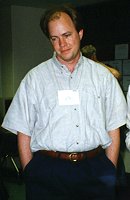
Spring/Summer 1999
Volume 6, Issue 2
Spring/Summer 1998
Volume
3, Issue 1
January 1995
Volume
2, Issue 4
October 1994
Volume
2, Issue 1
January 1994
 |
Parallel Profiles - John ReyndersStaff Scientist, Advanced Computing Laboratory, Los Alamos National Laboratory
|
John Reynders works in the area of object-oriented design and computer languages for the development of parallel scientific applications on high-end supercomputers. This research is a breakthrough from the traditional procedural approach to scientific simulation by adopting a new methodology based on object-oriented methods. It addresses the need for new paradigms to harness the complexity of multi-physics simulations and clustered, hierarchical, symmetric multiprocessing systems typical of today's high-performance machines.
"The combination of object-oriented parallelism and scientific computing makes this a challenging research area," says Reynders. "However, the payoff has been significant. Researchers adopting this new paradigm are discovering that they can go from simulation designs to working codes on a large class of distributed-memory parallel supercomputers with far less effort than procedural approaches."
According to Reynders, these methods are allowing physicists to develop simulations on serial workstations and then recompile on a parallel supercomputer to obtain orders of magnitude turnaround in their project results. "These scientists are able to accomplish this feat with no knowledge of parallel architectures," he says. "Indeed, it seems that parallel, object-oriented methods have truly made the laptop-to-teraflop path an easier one to travel."
Reynders has been a scientist at the Advanced Computing Laboratory at Los Alamos National Laboratory (LANL) since 1994. He was team leader of Parallel Object-Oriented Methods and Applications from 1995 to 1997, and is currently senior project leader of the Problem Solving Environment (PSE) Accelerated Strategic Computing Initiative. He is collaborating with CRPC researchers at Caltech, Drexel University, and Indiana University on the PSEware Project, where he focuses on building object-oriented libraries (see "Object-Oriented Library Efforts: POOMA, Tulip, and PAWS," this issue.
Reynders received a B.S. in mathematics from Rensselaer Polytechnic Institute in 1986. He worked as a research assistant at the Acoustics Division of the Naval Ocean Systems Center in San Diego in the summer of 1996 and at the Laboratory for Computational Physics at the Washington D.C.-based Naval Research Laboratory in the summer of 1997. He earned a Ph.D. in applied and computational mathematics from Princeton University in 1992 and performed his postdoctoral work at LANL from 1992 to 1994.
"In the sciences, one seems to be given the choice of being either in theory or experimentation. Applied and computational mathematics appealed to me as a third branch of science -- simulation," says Reynders of his chosen research field. "With researchers now sustaining teraflops computing and beyond, simulation of this scale can provide a window into nature that cannot be measured by experiment, and cannot be approximated by theory."
In addition to his research at LANL, Reynders is an adjunct professor at New Mexico State University and is an instructor at the University of New Mexico-Los Alamos. He has authored or co-authored numerous papers in the area of object-oriented simulation and related areas, and recently co-chaired the first International Symposium on Concurrent, Object-Oriented, and Parallel Environments, held in Los Angeles in September. His honors include the Ray Grimm Memorial Prize for Computational Physics from Princeton, an Office of Naval Research Fellowship, and the RPI Maxwell Mathematics Prize.